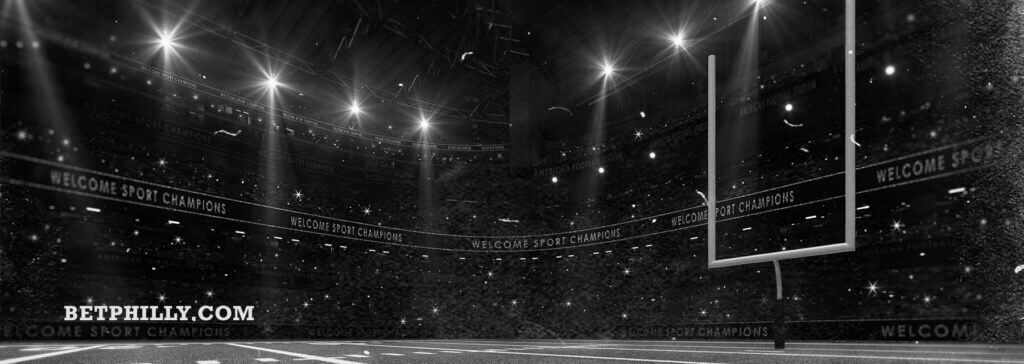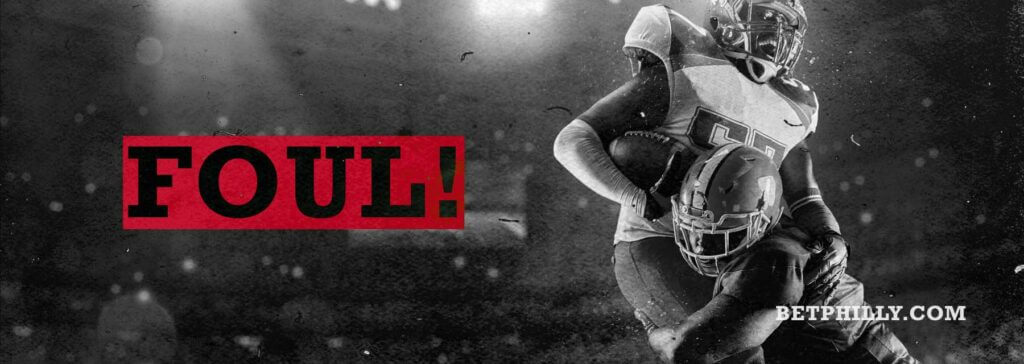Become an expert in no time
NFL is ranked the most popular sport within the US and has the highest average spectator attendance out of any other major league sport. Here we will provide you with the knowledge you need about NFL Betting rules when betting on a Betting Site
To become a successful NFL bettor in Pennsylvania, it’s paramount you are aware of everything that is going on. By holding this knowledge about the NFL Betting rules, you will know when and where to put your money.
This article will focus on the rules of the game, if you are looking for NFL betting rules and odds you better go here.
Basic NFL Rules
NFL rules are sometimes complicated. At the most basic level, the game is played in yards. The teams get four chances otherwise known as ‘downs’ to move the ball at least 10 yards down the field towards their opponent’s goal-line.

For every 10 yard progression they make, the downs are reset. If the team doesn’t make it 10 yards after four downs, the other team gains possession of the football.
Before the fourth down teams will often play one of two tactical moves. They will attempt to kick a field goal if they are close enough to score through the posts.
Alternatively, they will throw (punt) the ball towards the opponents’ end of the field. The latter means that once the other team takes possession, they are further away from the goal-line.
Game Objective
Similar to many sports, the NFL rules state that the aim is to score points. In football, players must work the ball down the field to deliver it into the endzone to score.
The most successful way to score is by having the quarterback throw downfield to a receiver. Alternatively, the running back can carry the ball downfield with the fullback protecting him as he carries it over the goal-line.
Field
An NFL playing field is 100-yards long. At either end, there is a 10-yard section known as the ‘endzone.’ Here players can score touchdowns. There is also a set of goalposts, which are the targets for kickers to kick the football through.
Player Roles
Player positions are primarily split into two categories: offensive and defensive. The offensive role is to work as a unit to take possession, move down the field, and score. They usually achieve this by scoring touchdowns or kicking to land a field goal.
Offensive roles
There are 8 offensive positions to specialize in. These include:
1. Quarterback: The quarterback is the leader. He is the one that calls plays, directs the team through signals, and gives orders at the line of scrimmage.
He is the player that receives the ball from the center and then makes the next tactical move. The quarterback is the only player who has direct communication with the head coach during play.
2. Center: The center is the player who snaps the ball up through the line of scrimmage to the quarterback.
3. Running back: Running backs are known for their agility and stamina. They are the players who run with the football.
4. Fullback: The fullback takes responsibility for defending the running back from opponents tackles. They will also take charge of pass-blocking to protect the quarterback’s moves.
5. Wide receiver: There can be as many as four wide receivers on the field at a time. It is their job to outpace the opponent defenders and catch the ball.
6. Tight end: The tight end wears two hats. They serve as a receiver and a blocker beside the offensive tackle on either side of the quarterback.
7. Left guard and right guard: They are the inner unit to the offensive line. Their role is to block and protect the quarterback and anyone who carries the football.
8. Left tackle and right tackle: These two players are the outer unit of the offensive line.
The defensive half of the team has an equally important role in keeping the opposition from scoring. Their job is to intercept the ball as it’s being thrown.
They must also tackle the offensive unit, and prevent any action that would mean the opposite team progress.
Defensive roles
There are five key defensive positions. These include:
1. Defensive tackle: Defensive tackles are the inner unit of the defensive line. They are responsible for stopping running plays and offense, running a gap to disrupt the formation or play of the quarterback.
2. Defensive end: The defensive end is the outer unit to the defensive line. Their role is in the backfield. They must overcome offensive blocking and tackle the opponent runners or quarterbacks. They are also tasked with pushing the opposition out of bounds or towards other defensive units.
3. Linebacker: Linebackers are the team’s best tacklers. They take up position behind the defensive lineman. There can be up to four linebackers on the field, depending on the formation. They must defend runs and passes.
4. Safety: The safety teammates are the last line in the defense. They must defend deep passes and runs.
5. Cornerback: Cornerbacks are positioned in the wide sections of the field opposite the rival receivers. It is their job to pick up the passes during wide throws or miss throws. The cornerback can turn the game around.
Scoring
There are several ways to score, and each approach has its own value, according to official NFL rules. A touchdown is worth six points, and it’s scored when the football is carried or caught over the goal-line in the endzone.
To score a touchdown the ball does not have to touch the ground; it merely needs to be within that zone

When a touchdown is scored, teams can then add additional points by choosing one or two options. The first is a conversion kick, where the kicker can kick through the goalposts for one extra point.
The second is an attempt to score a touchdown from a two-yard line for an additional two points.
As previously mentioned, teams can also kick a field goal, which is usually the tactic when they are on the fourth down in the opponent’s half. This awards three points.
Player and Team Rules
A full NFL roster consists of up to 50 players. However, according to current NFL rules, only 11 can be present on the field at any given time. Like previously explained, the playing team is made up of primarily offensive and defensive players.
Each player trains and specializes in a specific position. Some of the positions are classed as tactical. These are the teammates who you will see being brought on and off depending on the coach’s tactical stance.
Coach Rules
There are several rules the coach must adhere to at the side of the field. The most prominent is “the Challenge.”
The head coach has two opportunities to challenge a controversial referee decision throughout a game. If both challenges are deemed correct, then a 3rd is awarded.
A challenge can be made anytime in the game apart from the last two minutes of every quarter. After this time, controversial plays are scanned by officials.
To call a challenge, the head coach throws a red flag onto the field. The referee will then stop the clock and run to the sidelines to watch the play on instant replay screens.
They have one minute to make a verdict, and the evidence must be deemed indisputable for the challenge to be granted. Possession and distances are often challenged. Penalty calls are not allowed to be challenged.
Time Limits and Game Duration
Each NFL game lasts for a total of 60 minutes. The game is made up of four 15 minute quarters. So far no questions right. But if we look at a potential scenario where the game is tied after 60 minutes, it gets a bit complicated.
What you also should know is that the NFL overtime rules differ depending of if it’s during regular season or during the NFL playoffs. Here we will go through each separately so there is no confusion.
NFL Overtime Rules – Regular season
The NFL ot rules are a bit softer during the regular season. This is because the game is not as critical as in the NFL playoffs where every game can make it or break it for a team. If the scores are a tie at the end of the game this is whats going to happen:
- 10 minute-period added
- A coin toss are made to see who will possess the ball
- Sudden death play – any score will end the game (Touchdown, field goal or safety)
- 2 timeouts are given to each team
- No point after try
- If no point after sudden death, the game is tied.
- No coach challanges
Overtime rules in NFL Playoffs
The overtime rules for the Playoffs in NFL are a bit “harder” than during the regular season. The limits are pushed in a different way when it’s about the get decided what team gonna make the Super Bowl.
The difference between overtime rules in NFL playoffs vs regular season is as follow:
- Overtime periods will keep on going with 10 minutes each, until one team has won.
- 2 minutes intermission between each overtime period
- The team loosing the first coin toss will choose who starts with the ball
- Three timeots
- If no winner after fourth overtime period, another coin toss will be made
Fouls and Violations
There are several instances where a player or team will suffer penalties for improper behavior during play. Many of the penalty worthy violations are set to ensure player safety and fairness of the game following the rules in NFL. These include but are not limited to:

Encroachment: If a defensive player goes over the line of scrimmage and makes contact before the ball is snapped. Five yards deducted.
Offside: If any part of a player’s body is over the scrimmage line or free-kick line once the football is in play. Five yards deducted.
Holding (Offensive): If and offensive players use body parts to prevent defensive tackling. Ten yards deducted.
Holding (Defensive): If a defensive player holds onto or tackles an offensive player that isn’t carrying the ball. Five yards deducted
Helmet to Helmet Collision, Horse Collar Tackle, Face Mask Violations: The team will incur an automatic first down. Plus a 15-yard deduction in these instances:
- Using helmets to helmet contact
- Grabbing the inside of shoulder pads to bring down an opponent
- Pulling on face masks when blocking or tackling
Other violations they must avoid include roughing the kicker and passer, delaying the game, and personal fouls.
Equipment
It is of utmost importance to the league that all players on the field must dress professionally in league-approved attire. They are a direct representation of the association. Therefore, they must not only use safety equipment but also showcase the league’s standards.
Mandatory equipment includes:
- Helmets and face protection with chin straps
- Team jerseys
- Pants
- Block color stockings
- Shoulder pads
Standard football shoes must be pre-approved by the league. The shoes in which a team wears are the most scrutinized aspect of the team’s equipment by the league.
Other pieces of equipment are also heavily regulated. The game balls brought by each team, for example, go through rigorous testing before being approved by the referee’s stamp.
Referee and Procedures
To become an NFL referee, one must attain years of experience and accreditation. Any potential referee must have membership in an accredited football organization first and gain at least five years of experience either at a minor level or college level to be considered by the NFL. A further ten years of experience will put you in the standing for NFL approval. This is the reason why many NFL referees are above 45 years old.
An NFL referee must be fit and able to keep up with the play. It is their responsibility to shadow everyone on the field to ensure fairness and uphold the rules. They must also track times, possession, and distances. To do all of this, they must be masters of the rules. When a challenge is flagged, the referee has the final authority ruling and can overrule other officials.
NFL Player Trading Rules
The most critical point of trading occurs before and during the NFL Draft. Once a player is drafted, they can only sign contracts with that team, or they lose a season worth of play. However, a trade can be orchestrated with another team.
Depending on the type of contract after three seasons, a player can become a registered free agent. They then have limited rights to negotiate a move, but the current team has the first refusal. If the offered salary gets to a point where the current team cannot match the amount, then trade for players and draft positions usually occurs. It’s these instances that players receive unthinkable salaries and clubs that wouldn’t otherwise end up with first-round draft picks.
Another pinnacle point of the movement is during free agency. When a player runs out their contract, they will enter free agency where they can freely negotiate with their teams. Key players to the team may be awarded a franchise tag that secures them for another year on the highest current position salary or 120% of their previous years’ salary, whichever is greater.
New Changes in Rules
Each year new rules are put forward by a whole host of people involved in the sport, and the NFL Competition Committee spends hours considering them. Every time the first question they ask is, how does this change improve the game?
One of the most significant and valuable changes was when video assist was brought onto the field to support official decisions. This update had a significant impact on saving time, getting calls right, and exercising the ref sees what the rest of the world sees on the many screens now present at games.
The 2019 season was another year of change for the NFL. A collection of rules were passed to put extra emphasis on the health of the players. These rules included stricter penalties on offensive holding and using helmets. A new kickoff structure that was trialed in 2018 has seen a 35% decrease in concussions.
New NFL rules announced in 2022
For the 2022/2023 season a lot of new NFL rules and recommendations were made. The update affected everything from injured reserved and practice squads, to ramp up periods.
IR Protocols – Injured reserves
The NFL IR protocols were adjusted so that injured players must spend at least 4 weeks on IR before they can get back to the team. Further, the NFL teams can only return 8 players from the list during a season.
Practicing squad
The amount of players in the practice squad have been increased from 12 to 16. Also, veterans are now allowed to include in the practice squad. Further, a player can be elevated up to 3 times without having to pass through wavers.
Except these changes, notable updates also include the following:
- Overtime playoff rule
- Free kick formation rule
- Cutdown of the roster date rules
- Update about the “helmet rule”
NFL betting rules for active players explained
The NFL has very strict betting rules for the active players in the NFL teams. In the official NFL gambling policy you can find following information about NFL betting rules:
“GAMBLING ACTIVITIES
NFL Personnel are restricted or prohibited from engaging in the following gambling-related
activities, regardless of whether such activities are legal:
Betting on Football: All NFL Personnel are prohibited from placing, soliciting, or facilitating
any bet, whether directly or indirectly through a third-party, on any NFL game, practice or other
event. This includes betting on game outcome, statistics, score, performance of any individual
participant, or any other kind of “proposition bet” on which wagering is offered.
Betting on Other Sports: All NFL Personnel other than Players are further prohibited from
placing, soliciting, or facilitating bets on any other professional (e.g., NBA, MLB, NHL, PGA,
USTA, MLS), college (e.g., NCAA football), international (e.g., World Baseball Classic,
World Cup), or Olympic sports competition, tournament or event.”
One of the hardest punishment regarding the NFL Betting rules were made in 2022 when Falcons wide receiver Calvin Ridley got suspended for at least the whole upcoming season, due too betting on NFL games.
The NFL is very clear about the NFL gambling policy so Calvin must have know that what he was doing was wrong. But at the same time, a whole season is a very hard penalty.
The hard penalty Calvin got is probably because the NFL want to make a statement to all other players, that this is not, and never will be, accepted.
